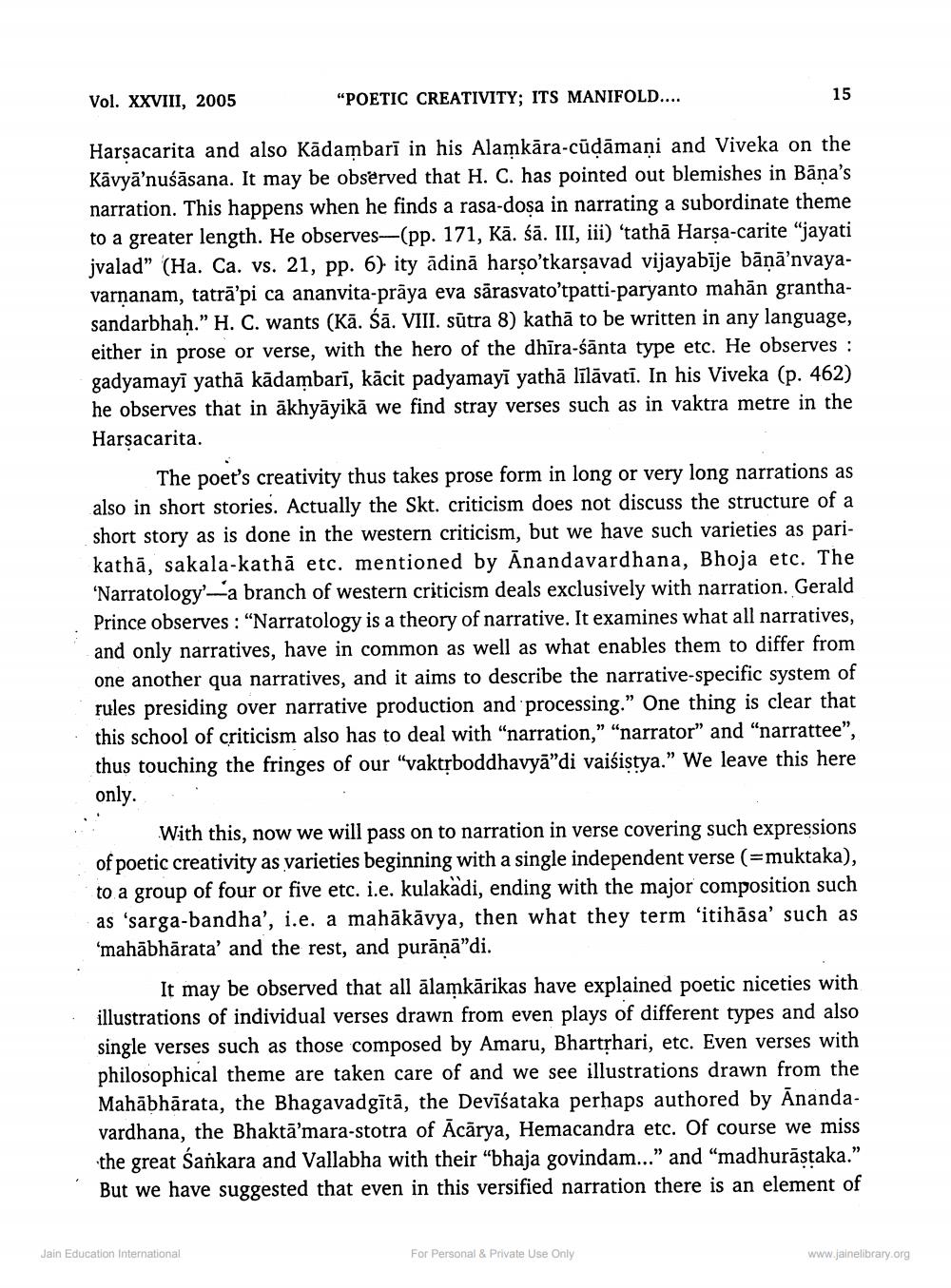________________
Vol. XXVIII, 2005
"POETIC CREATIVITY; ITS MANIFOLD....
15
Harsacarita and also Kādambari in his Alamkāra-cūdāmani and Viveka on the Kāvyā'nuśāsana. It may be observed that H. C. has pointed out blemishes in Bana's narration. This happens when he finds a rasa-dosa in narrating a subordinate theme to a greater length. He observes—(pp. 171, Kā. śā. III, iii) 'tathā Harsa-carite “jayati jvalad” (Ha. Ca. vs. 21, pp. 6) ity ādinā harşo'tkarşavad vijayabīje bāņā’nvayavarnanam, tatrā'pi ca ananvita-prāya eva sārasvato'tpatti-paryanto mahān granthasandarbhah.” H. C. wants (Kā. Šā. VIII. sūtra 8) kathā to be written in any language, either in prose or verse, with the hero of the dhīra-śānta type etc. He observes : gadyamayi yathā kādambarī, kācit padyamayi yathā līlāvati. In his Viveka (p. 462) he observes that in ākhyāyikā we find stray verses such as in vaktra metre in the Harsacarita.
The poet's creativity thus takes prose form in long or very long narrations as also in short stories. Actually the Skt. criticism does not discuss the structure of a short story as is done in the western criticism, but we have such varieties as parikathā, sakala-kathā etc. mentioned by Anandavardhana, Bhoja etc. The 'Narratology-a branch of western criticism deals exclusively with narration. Gerald Prince observes: "Narratology is a theory of narrative. It examines what all narratives, and only narratives, have in common as well as what enables them to differ from one another qua narratives, and it aims to describe the narrative-specific system of rules presiding over narrative production and processing." One thing is clear that this school of criticism also has to deal with "narration," "narrator" and "narrattee", thus touching the fringes of our "vaktrboddhavyā"di vaisistya." We leave this here only. .
With this, now we will pass on to narration in verse covering such expressions
With this of poetic creativity as varieties beginning with a single independent verse (=muktaka),
up of four or five etc. i.e. kulakadi, ending with the major composition such as 'sarga-bandha', i.e. a mahākāvya, then what they term 'itihāsa' such as 'mahābhārata' and the rest, and purānā"di.
IL
It may be observed that all alamkārikas have explained poetic niceties with illustrations of individual verses drawn from even plays of different types and also single verses such as those composed by Amaru, Bhartrhari, etc. Even verses with philosophical theme are taken care of and we see illustrations drawn from the Mahābhārata, the Bhagavadgītā, the Devīśataka perhaps authored by Anandavardhana, the Bhaktā'mara-stotra of Ācārya, Hemacandra etc. Of course we miss the great Sankara and Vallabha with their “bhaja govindam...” and “madhurāstaka.” But we have suggested that even in this versified narration there is an element of
Jain Education International
For Personal & Private Use Only
www.jainelibrary.org




